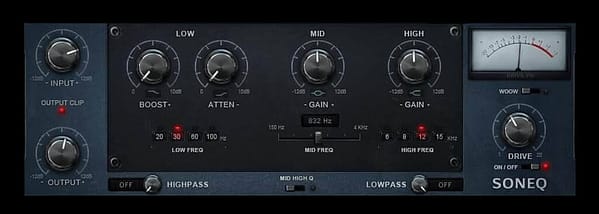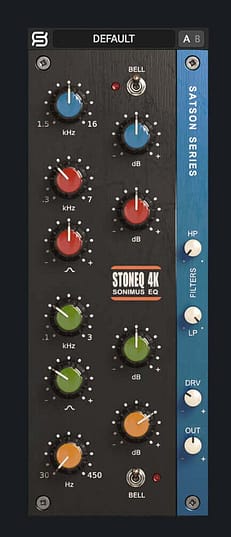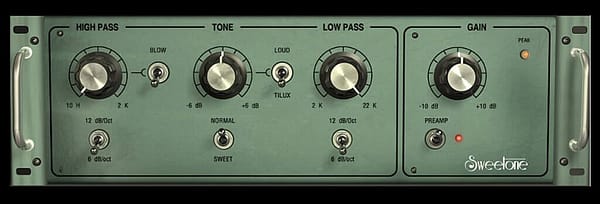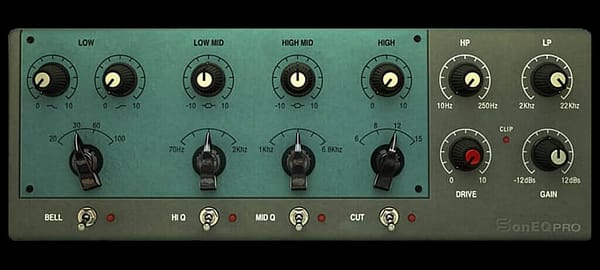Equalisers are one of the most important tools for any audio engineer. They help us clean, shape and enhance the qualities and character of our tracks. In a previous article we explained how equalisers work and the fundamentals behind these analog devices and their plug-in equivalents in modern digital audio. So, how many types of EQs are there and how do we know when to use one over the other? Let’s dive into it!
Passive or Active
Equalisers can be classified by the way they are constructed. When we talk about passive or active EQs we are referring to the way the circuit of the analog device is designed.
A passive equaliser relies on passive electronic components such as capacitors, inductors and resistors, to accomplish the desired effect. The EQ curves that can be obtained with these kinds of devices are limited to high-pass and low-pass filters, and basic band-pass filters with gentle slopes. That’s part of the magic and charm from these types of equalisers, they provide body and smooth sounds, without sounding aggressive or harsh. The inherent loss of signal level using passive equalisers is counteracted by coupling an amplifier to compensate for this loss. One of the most beloved passive equalisers is the EQP-1A which uses a tube preamplifier in its circuit, adding extra warmth and harmonic distortion characteristic from this kind of amplifier. Used in everything from drums, vocals, guitars or mix busses, the EQP-1A added weight and character to anything that passed through its circuitry. Sonimus added some of the sonic features and classic controls from this EQ unit when designing their SonEQ line, especially in their free well-known plug-in, SonEQ.
On the other hand, active equalisers add amplification stages throughout their design to avoid the level loss on each step of the circuit. On top of that, they reduce distortion, unwanted non-linearities and provide more control over the frequency response. Most modern EQs (both analog and digital) use this type of design to boost or attenuate frequencies. SSL-like equalisers such as StonEQ 4K are inspired and designed after active EQ units and are known for their transparency and controllability.
Filters, Shelves and Bells
Depending on the way equaliser boosts or attenuates the frequency spectrum we can classify them by shape as: filters, shelves or peaks.
Filters
We’ve talked about filters in our blog before. They are primarily used for the removal of unwanted content in our signal like rumble or hiss. Most preamplifiers and equalisers will provide a filter section with variable or non-variable controls, including the cut-off frequency, to specify the frequency at which the audio will be attenuated; or slope, providing control over the rate of attenuation (in dB/octave).
Sonimus understands how powerful this type of EQ is and makes sure to implement them on all their EQ plug-ins and console emulations, allowing to shape the sound of your mix right from the start of your chain.
Shelving EQ
Shelving equalisers allow a constant attenuation or boost above or below a given frequency. The frequency at which the shelving is applied indicates where the boost or attenuation will reach a maximum stable level.
Shelving EQs are really powerful to sculpt sound but should be used alongside filters to avoid boosting unwanted content. Sweetone is a great example of how using shelving EQs in combinations with high-pass and low-pass filters can effectively speed up your workflow and easily get mix-ready sounds in your vocals, guitars or overall mix.
Peak EQ
Peak equalisers focus on boosting or attenuating specific frequencies, creating bell-like shapes in the frequency spectrum. That’s why they are also known as Bell EQs.
The area of effect of this type of EQs is known as bandwidth. It’s normally given in octaves or by a single number known as Q or quality factor. Some digital EQs can offer extremely narrow Q values, difficult to be reached by analog devices, allowing for surgical removal of specific frequencies.
Depending on the amount of control over this parameter, equalisers can be fixed, semi or fully parametric. If the control of the Q value is continuous, the EQ is considered fully parametric, while if the same control is non-continuous or stepped, they are labelled as semi-parametric. Burnley 73 is a classic example of fixed Q with no control over the bandwidth of each band. SonEQ Pro and SonEQ 2 are semi-parametric equalisers, while StonEQ 4K is the classic representation of fully parametric equalisers.
You should choose which EQ is better for the work depending on how precise and surgical you want to be with your EQ moves.
Dynamic EQs
Finally, dynamic equalisers are a more modern approach to the traditional equalisation. Blending the features and controls of an EQ and a multiband compressor, it allows the equaliser to react to the sound source at each point in time.
Similarly to a multiband compressor, the dynamic EQ will boost or cut frequencies as the signal reaches a certain threshold, but instead of traditional crossovers, dynamic EQs allow the use of filters and EQ shapes to get full dynamic control over the frequency spectrum.
Some DAWs like Reaper let users use any track as a sidechain to a specific plug-in. A super powerful tool if you combine it with plug-ins such as SonEQ 2 or StonEQ 4K, allowing you to create custom dynamic EQs in your sessions.
Which Sonimus equaliser is your go-to EQ? Do you use different ones in different scenarios? Let us know in the comments below and don’t forget to subscribe to our newsletter to get mixing tips and all the info about Sonimus plug-ins right in your inbox.













Leave A Comment
You must be logged in to post a comment.